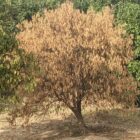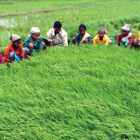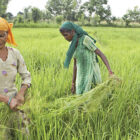A refusal to understand and learn from farmer experience has been the bane of Indian agriculture. So has the refusal to invest in Indian research and development.
Indian indigenous knowledge provides its own signals in terms of interpreting and even predicting natural phenomena. In their glorious ignorance, practitioners of modern science sometimes fail to notice these signals, leave alone interpret them. The Indian farmer, likewise, has a native intelligence, which policy makers often choose to overlook.
As a farmer, preparing my land to sow my guar crop under the sweltering June sun, on tractor, I observe that the ‘titudi’ (red wattled lapwing) has laid its eggs on a “doli” — a small embankment between fields to help watering by the flood irrigation method. This is significant because it is believed that a titudi lays its eggs on a raised platform when it senses a normal monsoon in the village. Otherwise, it finds flat ground for this purpose. It never lays its eggs on trees. Animal instinct is something even science recognises.
Newspapers are already reporting uneven rains. The country being so large with monsoons patterns not yet fully understood, one can never predict the actual outcome. The met office is cautiously seeking to unravel the monsoon mystery in a bid to predict correctly. Predictions, however, have to be made tehsil/taluk-wise to be of any use to individual farmers and the met office needs to be a far more credible predictor than the titudi. Otherwise, it might as well post a flight of lapwings all over the country to predict the mind of the monsoon.
A refusal to understand and learn from farmer experience seems to have been the bane of Indian agriculture. The key findings of the study on the social impact assessment of Bt cotton, commissioned by the Bharat Krishak Samaj, clearly validate my personal experience and that of most farms on my radar. Hybrid Bt cotton farmers continue to be better off even as sceptics insist that Bt farmers are making considerable losses. They fail to acknowledge that more than 90 per cent of cotton farmers have been growing Bt cotton year after year for a decade now. The wisdom of 70 lakh cotton farmers should surely amount to more than that of a few individuals.
In the book, ‘Wisdom of Crowds’, New Yorker columnist, James Surowiecki, explores a deceptively simple idea: large groups of people are smarter than an elite few – no matter how brilliant – better at solving problems, fostering innovation, coming to wise decisions and even predicting the future. He offers a great introduction to applied behavioural economics by stating that a crowd’s “collective intelligence” will produce better outcomes than that of a small group of experts.
Bt technology does not increase yield but only enables more cotton balls to mature per acre than before with reduced pesticide usage, to deliver a higher net yield and profit per acre. As a farmers’ organisation, one may not be adequately qualified to pass scientific judgment on the technology or its impact on the environment. One can, however, talk of actual experience without fear of being contradicted. In my village, the reduced use of pesticides has led to the return of the birds, bees and butterflies to the fields. Apart from better yield, farmers have also gained considerably from the increase in price of cotton over the years. It is government policy that actually determines farmer profitability more than anything else.
In the pages that follow, readers will come across a farmer who cultivates non-BT cotton. The underlying message is that the BKS, as an organisation, respects the right of the farmer to choose his crop. As an organisation, the BKS propagates prosperity for the farmer and holds his right to choose as paramount. Unfortunately, people and policy makers tend to disagree. Abohar, the town from where I buy my agriculture inputs, had the dubious distinction of recording the second highest sales of pesticides in Asia.
This phenomenon exterminated the entire muster of peacocks that had been around even when I was a teenager. In fact, there are more peacocks in Delhi today than in all of Punjab put together. The return of the vultures, last seen a decade ago, usually feasting on animal carcasses on village outskirts, is eagerly anticipated today. The one thing that the government agencies and the non-government organisations have in common is their ability to fudge data and disburse them as facts, courtesy willing news channels.
There are other concerns around the Bt story though: the higher price for hybrid Bt cotton seeds that the Punjab farmers were officially going to be charged, for instance. The BKS’ recent intervention, through the leader of the opposition in the Punjab Vidhan Sabha, Sunil Jakhar, led to compelling deliberations in the Assembly that forced the government to reduce the sanctioned maximum retail price of the packet. Farmers were consequently spared an expense of more than ₹12 crores on account of cost of cotton seeds alone.
The point here is that the voice of the farmer needs to be respected. Even Abhijit Sen, member, Planning Commission, said that GM crops were here to stay. Jairam Ramesh has said that more farmers are growing Bt and that rational decision-making by farmers must be respected. Yet there are so many discordant voices that remind one of anthropologist Ruth Benedict’s observation that “the trouble with life is not that there is no answer, it is that there are so many answers”.
The sustained NGO action against GM technology in India also has a peculiar side effect. The same multinationals that these NGOs hate are being strengthened because, by opposing them, these NGOs prevent Indian talent from focusing on emerging technology. These companies have a head start on Indian research institutions and, at this rate, India will always remain dependent on them and forever play the catch up game.




